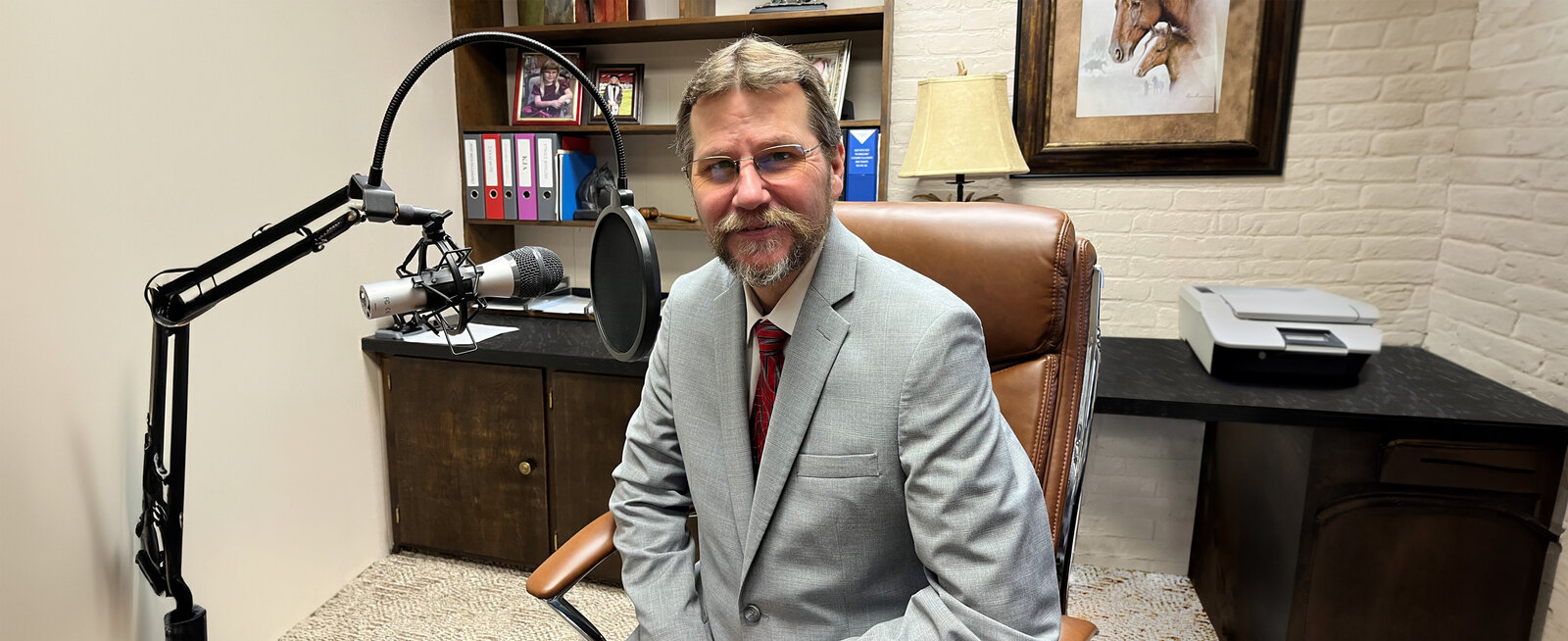Episode 42: Calloway County social security disability attorney Jeff Roberts explains the Continuing Disability Review (CDR) process and how it can impact someone receiving social security disability insurance benefits (SSDI) or supplemental security income benefits (SSI). Jeff also maintains an office in Christian County to better serve clients in that area of Western Kentucky.
As an attorney, Jeff focuses on personal injury, workers’ compensation and social security disability claims. He’s practiced in Western Kentucky for 30 years and has helped many clients to effectively deal with the continuing disability review process.
What Is a Continuing Disability Review?
Jeff explains that the Social Security Administration can and will review a case involving someone receiving benefits. The individual will receive a letter informing them of the continuing disability review. This process enables the Administration to determine whether that person should continue to receive benefits.
Some situations involve an injury that may heal over time. That injury may be treated by a surgery or series of surgeries, which could enable to the person to return to the job market. This frequently happens with spinal injuries. It’s not uncommon for a review date to be entered into the system, once the person is deemed to have some level of disability. When that date arrives, the letter regarding the continuing disability review will be issued.
Again, the CDR process is to ensure the person qualifies for disability benefits.

Did I Do Something to Trigger My Continuing Disability Review?
Typically, no. As we discussed, a recommended review may have already be entered into the system. The government wants to ensure the benefit funds are being used to help those who qualify for disability payments. The review process could be considered an audit. If someone is receiving SSI benefits, as a minor, they will normally undergo a CDR around the time they reach the age of 18.
How Does the Continuing Disability Review Process Work?
It begins with the letter issued by the Social Security Administration. The individual will receive a detailed form to complete. The form asks for updates to their medical treatment history, doctor visits, current treatment, has the person done any vocational rehabilitation or gone back to work.
After the form has been reviewed, the Administration may ask you to sign a medical authorization so your medical records can be reviewed. This may be enough for the decision to continue your disability benefit payments. There may be a determination that additional information may need to be investigated. This may be enough to satisfy status and the individual may not undergo a CDR for another 5-7 years.
Jeff stresses that it’s important for you to continue seeing your specialist or family doctor, if that’s recommended by the provider. Don’t neglect medical appointments. When the review happens, it’s helpful for the Administration to see that you’ve continued seeking treatment and provided updates to your doctor(s) about your status, especially if you’re still experiencing pain or limitations because of the injury. Documentation in your medical record is important to your case.
Medical Breakthroughs Can Trigger a Continuing Disability Review
Medications, surgical procedures, treatments and other advances are made on a daily basis. Once one of these new options has become more common, those who could benefit from this breakthrough are assumed to have possibly benefitted from it. This could trigger a continuing disability review. Again, this is to ensure you still qualify to receive disability benefits. If you underwent a procedure and you are doing much better, you may be able to begin working, again.
Returning to Work Can Trigger a Continuing Disability Review
Jeff tells many of his clients that it’s better for a person’s physical, mental and financial situation to return to work, if they are able to do so. You have the option of notifying the Social Security Administration to establish a trial work period. This is an extended period of time to allow you to see if you are able to work. Jeff explains it could be 9 months or so. If you can continue working that’s good news. You may find that you are unable to continue working.
You’ll receive your disability benefit payments during this trial period, in addition to any income you generated.
It’s important to understand you are required to notify Social Security, when you return to work. If you don’t notify them, they could come back and require you to reimburse the Administration for the benefits you received, after returning to work.
What Happens if I’ve Completed the Trial Work Period and later Decide I Can’t Work?
If you completed the trial work period and you were taken off of disability, then decide you can’t keep working, you would be required to open a new claim. Jeff explains this is the reason the period lasts for such a long period of time.
Can an Ex-Spouse Trigger a Continuing Disability Review?
Unfortunately, some people do attempt to cause problems for an ex-spouse or significant other, after a divorce or break-up. From time to time, the Administration receives notification from people claiming to know the former spouse or significant other is not actually disabled. This can obviously trigger a Continuing Disability Review, whether it’s warranted or not. Jeff comments that he wished the Administration would do a better job of filtering some of these potentially false, but malicious claims.
Vocational Rehab Can Cause a Continuing Disability Review
If you are undergoing vocational rehabilitation, the goal is to try to get you to a point at which you can return to work. This is also the case if you’ve gone back to school and completed your degree. That achievement should enable you to seek employment, although it may be in a different type of job.
Understand these are positive achievements. As Jeff stated earlier, going back to work is almost always better than remaining on disability, in his opinion. Nonetheless, these events will usually trigger a CDR to determine if you are still eligible to receive disability benefits.
What Happens after the Continuing Disability Review is Completed?
If the CDR determines that you are still disabled, the benefits continue as they did, before the review.
If the CDR causes Social Security to determine you are no longer disabled, they will send you a letter informing you of your last scheduled disability benefits payment. This cessation of payments is usually about 2 months later. You are also given time to appeal the decision, regarding your eligibility for disability.
Important: There is a brief window of time to notify the Administration that you wish to continue receiving benefits, during your appeal. In this case, you would continue receiving payments until a final decision is determined. Delays due to the mail and quickly eat into the available days you have to notify the Administration. It may also take time to hire an attorney to assist you with your appeal.
If you win the appeal, you’ll continue to receive your benefit payments. If you lose the appeal, it may be possible for you to get them to waive repayment of the benefits you received during the appeal process. It’s not guaranteed, but Jeff has been successful in getting those waivers for clients.
Attorney Fees for the Appeal
If Jeff helps you with your appeal, this is considered a new claim and thus, subject to additional attorney fees. Normally, the attorney fees are paid from a portion of the back payments of social security disability claim. Because an appeal doesn’t involve back payments, assuming the client opted to continue receiving benefits during the appeal, arrangements between Jeff and the client will need to be made. If Jeff is not successful in your appeal, he returns the fees from that arrangement.
Be Careful with What You Post on Social Media
In closing this episode, Jeff offers a final word of advice. He recommends that people consider what they are posting on social media. If they are receiving disability and post an old picture of themselves engaging in an activity that would call into question their actual status, make sure to note that the photo was taken before the injury. Always be truthful. But it’s easy to understand how a picture of you waterskiing on Lake Barkley might negatively impact a continued disability review.
Jeff Roberts Represents Injured Clients Throughout Kentucky
With offices located in Calloway County and now Christian County, Jeff actually has a history of representing personal injury clients, workers’ compensation clients and social security disability clients across the state. He’s represented clients from Paducah, Bowling Green, Louisville, Covington, Whitesville and many other Kentucky locations. He’s not just a Western Kentucky injury attorney.
We hope you found this episode insightful and helpful. Thank you for listening!
Is It Time to Speak with an Attorney about Your Social Security Claim?
The office phone number is (270) 753-0053 or toll free at 800-844-5108. For more information, visit www.JeffRobertsLaw.com. This podcast is meant to provide information and is not legal advice. Jeff’s principal office is located at 509 Main Street, Murray, Kentucky. Co-host Jim Ray is a non-attorney spokesperson. This is an advertisement.




